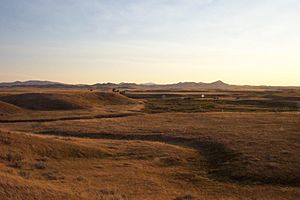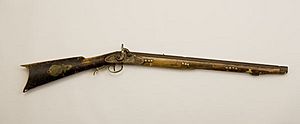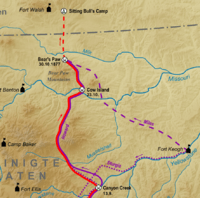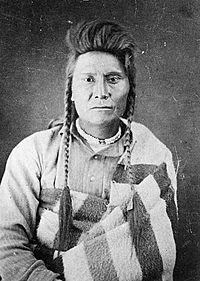Battle of Bear Paw facts for kids
Quick facts for kids Battle of Bear Paw |
|||||||
|---|---|---|---|---|---|---|---|
| Part of the Nez Perce War | |||||||
 Bear Paw Battlefield |
|||||||
|
|||||||
| Belligerents | |||||||
| United States of America | Nez Perce | ||||||
| Commanders and leaders | |||||||
| Nelson A. Miles Oliver Otis Howard |
Chief Joseph Looking Glass †< Ollokot † White Bird Toohoolhoolzote † |
||||||
| Strength | |||||||
| 520 | 700 <200 warriors |
||||||
| Casualties and losses | |||||||
| 24 dead 49 wounded (including 2 Indian scouts) |
23 men and 2 women killed 46 wounded 431 surrendered or captured |
||||||
|
Chief Joseph Battleground of the Bear's Paw
|
|
| Nearest city | Chinook, Montana |
|---|---|
| Built | 1877 |
| NRHP reference No. | 70000355 |
| Significant dates | |
| Added to NRHP | October 6, 1970 |
| Designated NHL | June 7, 1988 |
The Battle of Bear Paw was the last major fight of the Nez Perce War in 1877. For four months, the Nez Perce people had traveled over 1,200 miles (1,900 km) from western Idaho. They were trying to escape the U.S. Army.
In early October 1877, the army finally trapped most of the Nez Perce. This happened in northern Montana Territory, about 42 miles (68 km) south of the Canadian border. The Nez Perce hoped to find safety in Canada.
Some Nez Perce did manage to reach Canada. But their leader, Chief Joseph, had to surrender most of his people. He surrendered to General Oliver Otis Howard and Colonel Nelson A. Miles on October 5. Today, the battlefield is part of the Nez Perce National Historical Park. It is also part of the Nez Perce National Historic Trail.
Contents
Why the Battle Happened
In June 1877, several groups of the Nez Perce people faced a big problem. The U.S. government wanted them to move from their traditional lands. They were told to go to a much smaller reservation in Idaho. The Nez Perce did not want to move.
So, they decided to escape. They traveled east through what is now Idaho, Montana, and Wyoming. They crossed the Rocky Mountains and reached the Great Plains. At first, they hoped to find a peaceful new home. But they soon realized their only safe place was in Saskatchewan, Canada. This was where the Lakota leader Sitting Bull had found safety.
After passing through Yellowstone National Park, the Nez Perce headed north. They were moving through Montana Territory toward Canada.
By late September, about 800 Nez Perce had traveled over a thousand miles. Fewer than 200 of them were warriors. They had fought several battles against the U.S. Army. They had either won or held off the soldiers chasing them. In their last battle on September 13, the Nez Perce escaped Colonel Samuel D. Sturgis. This was at the Battle of Canyon Creek near Billings, Montana.
However, scouts working for Sturgis captured about 400 Nez Perce horses. This slowed the Nez Perce down. General Howard joined Sturgis and continued chasing the Nez Perce north.
On September 12, General Howard sent a message to Colonel Nelson A. Miles. Miles was at Fort Keogh. Howard asked for his help. Miles received the message on September 17. He decided to move his soldiers northwest. He wanted to stop the Nez Perce before they reached Canada. Both officers feared the Nez Perce might join forces with Sitting Bull's Lakota.
Howard slowed his chase to give Miles time to get into position. The Nez Perce were very tired from their long journey. They also slowed down, thinking they were far ahead of Howard. They did not know Miles was coming quickly from another direction.
As they traveled north, the Nez Perce raided some ranches for horses and food. They were trying to survive.
Many Americans, and even some in the army, felt sympathy for the Nez Perce. An army surgeon said he admired their bravery. However, army leaders like William Tecumseh Sherman and Philip Sheridan wanted to punish them. They wanted to stop other Native American groups from fighting back.
Crossing the Missouri River
On September 23, the Nez Perce crossed the Missouri River near Cow Island Landing. This was a place where steamboats unloaded goods. A small group of about a dozen soldiers guarded these supplies.
When the Nez Perce arrived, the soldiers and two civilians retreated into their camp. The Nez Perce crossed the river and camped nearby. A small group of Nez Perce asked the soldiers for food. They were given only a small amount. Later that night, the Nez Perce surrounded the soldiers' camp. They took the supplies and set them on fire. Two civilians were hurt.
The next morning, the Nez Perce continued their journey. They were only 90 miles (140 km) from the Canadian border. The soldiers sent a message to Colonel Miles about the Nez Perce's location. Soon, the Nez Perce found another wagon train with supplies. They looted and burned it too. They also stopped 50 soldiers and volunteers who tried to chase them.
During these raids, the Nez Perce killed five men. They also stole or destroyed a lot of military supplies. But these actions cost them a day of travel. Historians believe this delay might have allowed the U.S. Army to catch up.
Leaders Disagree
The Nez Perce did not have one single leader during their long journey. Looking Glass was an important military leader. Chief Joseph mostly managed the camp. A man named Poker Joe, who was part French and Nez Perce, became a guide and interpreter. Poker Joe understood how determined the U.S. Army was to catch them.
After the Canyon Creek battle, General Howard's forces were far behind. Looking Glass wanted to slow down. He thought the people and horses needed rest. Poker Joe disagreed. He wanted to keep moving quickly.
The leaders argued on September 24. Poker Joe gave in to Looking Glass. He reportedly said, "Looking Glass, you can lead. I am trying to save the people. I want to cross into Canada before the soldiers find us. You can take command, but I think we will be caught and killed."
Looking Glass took charge. The Nez Perce moved slowly toward Canada for the next four days. They watched for Howard's soldiers from the south. But they did not know Miles was coming fast from the southeast.
Miles Finds the Nez Perce
Colonel Miles left Fort Keogh on September 18. He had 520 soldiers, civilian workers, and scouts. About 30 of his scouts were Native Americans, mostly Cheyenne and some Lakota. Some of these scouts had fought against George Armstrong Custer at the Battle of the Little Bighorn just 15 months earlier.
Miles wanted to catch the Nez Perce quickly. He marched his troops fast toward the northwest. He hoped to find them south of the Missouri River. He planned to move along the south bank of the Missouri. At the Missouri, scout Luther Kelly joined Miles.
On September 25, Miles learned about the Cow Creek fight. He found out the Nez Perce had crossed the Missouri and were heading north. So, he changed his plan. He crossed the Missouri and headed toward the north side of the Bears Paw Mountains. Miles tried to keep his army's presence a secret. He believed the Nez Perce were only a few miles to his west.
On September 29, several inches of snow fell. That day, Miles' Cheyenne scouts found the Nez Perce trail. Some soldiers and civilian scouts had a small fight with Nez Perce warriors. The next morning, the Cheyenne found the Nez Perce camp. It was on Snake Creek, north of the Bear Paw Mountains. Miles' soldiers moved toward it.
That same day, Nez Perce scouts told their leaders that many people were to their east. Most Nez Perce leaders wanted to keep going quickly to Canada. But Looking Glass convinced them to stay. He said the people seen must be other Native Americans, like Assiniboine or Gros Ventre, who hunted in the area. So, the Nez Perce camped on Snake Creek, only 42 miles (68 km) from Canada. On September 30, they slowly prepared to continue their journey.
The Battle Begins

Miles rushed his attack on the Nez Perce camp. He was afraid they would escape. At 9:15 AM, about six miles (9.7 km) from the camp, he sent his cavalry forward. The 30 Cheyenne and Lakota scouts led the way. Then came the 2nd Cavalry battalion, with about 160 soldiers. They were ordered to charge into the Nez Perce camp. The 7th Cavalry battalion, with 110 soldiers, followed as support. The 5th Infantry, about 145 soldiers on horses, followed as a reserve. They had a Hotchkiss gun and supplies. Miles rode with the 7th Cavalry.
Miles used a common army tactic against Plains Indians. This was to attack a village suddenly. The goal was to shock everyone before they could fight back. However, Nez Perce scouts warned their people a few minutes before the soldiers arrived. The Nez Perce were scattered. Some were gathering horses, others were packing to leave.
Some men quickly got ready to defend the camp. About 50 to 60 warriors, and many women and children, ran out of the village. They tried to escape to Canada.
Miles' plan quickly fell apart. The Cheyenne scouts did not attack the camp. Instead, they turned left toward the horse herd. The 2nd Cavalry, led by Captain George L. Tyler, followed them. The Cheyenne and Tyler captured most of the Nez Perce horses. This cut off about seventy men, including Chief Joseph, plus women and children, from the village. Joseph told his 14-year-old daughter to get a horse and escape to Canada. Joseph, who was not armed, then rode back into the camp. Several bullets cut his clothes and wounded his horse.
Tyler's detour meant he was not part of the main battle. He sent one company to chase the Nez Perce heading to Canada. This company chased them about five miles (8.0 km). Then they had to retreat as the Nez Perce fought back. Once the women and children were safe, some Nez Perce warriors returned to help their main force.
While the Cheyenne and 2nd Cavalry chased horses, the 7th Cavalry, led by Captain Owen Hale, continued toward the village. As they got close, a group of Nez Perce jumped up from a hidden ditch. They opened fire, killing and wounding several soldiers. The soldiers fell back. Miles ordered two of the 7th Cavalry companies to get off their horses. He quickly brought up the mounted infantry, the 5th, to join the fight. Another company, Company K, got separated and also took losses. By 3:00 PM, Miles had all his forces organized. They were on higher ground. The Nez Perce were surrounded and had lost all their horses. Miles ordered a charge on the Nez Perce positions, but it was pushed back with many casualties.
By nightfall on September 30, Miles' army had 18 dead and 48 wounded. This included two wounded Native American scouts. The 7th Cavalry had the most losses. Its 110 men had 16 dead and 29 wounded. The Nez Perce had 22 men killed. This included three leaders: Joseph's brother Ollokot, Toohoolhoolzote, and Poker Joe. Poker Joe was accidentally killed by a Nez Perce sharpshooter who thought he was a Cheyenne. Several Nez Perce women and children were also killed. Miles later said this battle was "the most fierce of any Indian engagement I have ever been in."
The Siege Begins
During the cold and snowy night after the first battle, both sides built up their defenses. Some Nez Perce secretly went out to collect ammunition from wounded and dead soldiers. The Nez Perce dug deep shelter pits for women and children. They also dug rifle pits for the warriors. These pits covered all ways to their camp, which was a square about 250 yards (230 m) on each side. About 100 warriors defended the camp. Each had several guns, including repeating rifles. A soldier said, "to charge them would be madness."
Miles was most worried that Sitting Bull might send Lakota warriors from Canada to help the Nez Perce. The next morning, soldiers thought they saw groups of Native Americans on the horizon. But they turned out to be herds of bison. Looking Glass was killed during the siege. He thought he saw approaching Lakota and raised his head to see better. A sniper's bullet hit him, killing him instantly.
The Cheyenne scouts may have started talks. Three of them rode into the Nez Perce defenses and suggested a meeting. Chief Joseph and five other Nez Perce, including Tom Hill, agreed to speak with Miles. Tom Hill was part Nez Perce and part Lenape, and he helped translate. During the truce, soldiers and warriors collected their dead.
When the talks failed, Miles seemed to take Joseph prisoner. A Nez Perce warrior, Yellow Wolf, said Joseph was tied up. But the Nez Perce quickly stopped Miles' action. A young lieutenant named Lovell H. Jerome wandered into the Nez Perce camp during the truce. The Nez Perce took Jerome hostage. The next day, October 2, Joseph was exchanged for Jerome.
On October 3, the soldiers fired again with a large 12-pounder gun. It did little damage to the Nez Perce, who were dug in. However, one woman and one small girl were killed when a shell hit a shelter pit. On October 4, General Howard arrived at the battlefield with an escort. Howard let Miles stay in charge of the siege.
Meanwhile, the Nez Perce leaders disagreed about surrendering. Joseph seemed to be in favor. But White Bird, the only other surviving leader, was against it. He wanted to break through the army lines and run to Canada. Joseph later said, "We could have escaped from Bear Paw Mountain if we had left our wounded, old women, and children behind. We were unwilling to do this."
The Surrender

General Howard suggested using Captain John and Old George, two Nez Perce men with him, to convince Joseph to surrender. Both men had daughters among the Nez Perce who were trapped. The next morning, October 5, at 8:00 AM, all firing stopped. The two Nez Perce went into Joseph's lines. They seemed to promise that no Nez Perce would be killed. They would also get blankets and food. They would be taken back to the Lapwai reservation in Idaho.
With these promises, Joseph agreed to surrender. White Bird also agreed. The two Nez Perce returned to the army lines with a message from Joseph. It was translated as follows:
Tell General Howard I know his heart. What he told me before I have in my heart. I am tired of fighting. Our chiefs are killed. Looking Glass is dead. Tu-hul-hul-sote is dead. The old men are all dead. It is the young men who say yes or no. He who led the young men [Ollokot] is dead. It is cold and we have no blankets. The little children are freezing to death. My people, some of them, have run away to the hills, and have no blankets, no food; no one knows where they are – perhaps freezing to death. I want to have time to look for my children and see how many of them I can find. Maybe I shall find them among the dead. Hear me, my chiefs. I am tired; my heart is sick and sad. From where the sun now stands I will fight no more forever.
Joseph's message is often called one of the greatest American speeches. The translator, Arthur "Ad" Chapman, was also the person who had fired at a Nez Perce peace group almost four months earlier. That event had started the war.
Chief Joseph, Tom Hill, and several other Nez Perce then met with Howard, Miles, and Chapman. Joseph said he was only surrendering his own group. Others would make their own choices. He later said that General Miles promised him, "If you come out and give up your arms, I will spare your lives and send you to your reservation."
At 11:00 AM, the surrender talks were finished. Joseph returned to his people. In the afternoon, Joseph came for the formal surrender. He was on a black pony. Five warriors walked beside him. Lieutenant Charles Erskine Scott Wood wrote about the surrender. He said Joseph's gray woolen shawl had bullet holes. His forehead and wrist were scratched by bullets. Joseph got off his horse and offered his Winchester rifle to General Howard. Howard told him to give it to Miles instead. Soldiers then took Joseph away. Lt. Wood said Joseph was very sad about his daughter. She had been separated from him early in the battle.
After Joseph surrendered, Nez Perce people came out of their pits. They gave their weapons to the soldiers. However, White Bird and about 50 followers slipped past the army lines. They continued to Canada. They joined other Nez Perce who had escaped earlier. General Howard thought White Bird's escape broke the surrender agreement. Yellow Wolf, a Nez Perce warrior, later said, "The surrender was just for those who did no longer want to fight. Joseph spoke only for his own band."
In total, 431 Nez Perce surrendered or were captured. This included 79 men, 178 women, and 174 children. Estimates vary, but about 233 Nez Perce escaped to Canada. This included 140 men and boys and 93 women and girls, including Joseph's daughter. Forty-five Nez Perce were captured on their way to Canada. At least five, and possibly up to 34, were killed by Assiniboine and Gros Ventre people. Miles had encouraged these groups to fight any escaping Nez Perce. However, some Nez Perce were helped by Cree people in the area. The Nez Perce who reached Canada were welcomed by Sitting Bull. But Canadian officials said they were in terrible condition.
The scout Chapman reported that soldiers captured 1,531 horses. The Cheyenne and Lakota scouts took 300 horses as payment. Colonel Miles ordered about 700 horses to be returned to the Nez Perce the next spring. But this never happened. Most other Nez Perce property was burned in a warehouse fire at Fort Keogh.
What Happened Next
The Nez Perce had made an amazing journey. They traveled 1,170 miles (1,880 km) across parts of four states. They were stopped just 40 miles (64 km) from safety in Canada. Chief Joseph's actions during the war impressed the whole nation. Howard and Miles praised the Nez Perce. Even General William Tecumseh Sherman praised their fighting skills. He also noted how few terrible acts they committed.
Miles had promised Joseph that his people would return to their homeland. But Sherman overruled this promise. The Nez Perce were sent to Kansas and Indian Territory. Howard and Miles protested this decision. In 1885, the Nez Perce were allowed to return to Washington. But Joseph was not allowed to live in his homeland in the Wallowa River Valley in Oregon.
Joseph became a powerful speaker for his people. He was well-known and respected by his former enemies in the U.S. Army and by the American public. He died on September 21, 1904, on the Colville Indian Reservation in Washington. His doctor said he died of a broken heart.
Ten Medals of Honor were given to soldiers after the battle. One interesting pair was for 1st Lt. Henry Romeyn and First Sergeant Henry Hogan. Hogan is one of only 19 American servicemen to win two Medals of Honor. He received his for carrying a badly injured Lt. Romeyn off the battlefield. This makes Hogan one of only three men to receive a Medal of Honor for rescuing another Medal of Honor winner. The medals were given out later, in 1884.
Today, the Bear Paw Battlefield is managed by the National Park Service. It is part of the Nez Perce National Historical Park. The site is 16 miles (26 km) south of Chinook. It is on County Route 240 in Blaine County, Montana. Experts surveyed the site in 1935. This team included Nez Perce veterans of the conflict. It was added to the National Register of Historic Places in 1970. It was named a National Historic Landmark in 1988.
Leaders and Forces
Here are some of the important leaders and groups involved in the battle:
United States Army
- Brigadier General Oliver Otis Howard
- Colonel Nelson A. Miles
- Headquarters Staff: 1st Lieutenant George W. Baird, 1st Lieutenant Frank D. Baldwin, 2nd Lieutenant Oscar F. Long, 2nd Lieutenant Marion M. Maus, Major Henry R. Tilton, 1st Lieutenant Edwin F. Gardner
- 7th U.S. Cavalry: Captain Owen Hale
- Company A – Captain Myles Moylan
- Company D – Captain Edward S. Godfrey
- Company K – Captain Owen Hale
- 2nd U.S. Cavalry: Captain George L. Tyler
- Company F – Captain George L. Tyler
- Company G – 2nd Lieutenant Edward J. McClernand
- Company H – 2nd Lieutenant Lovell H. Jerome
- 5th U.S. Infantry: Colonel Nelson A. Miles
- Company B – Captain Andrew S. Bennett
- Company F – Captain Simon Snyder
- Company G – 1st Lieutenant Henry Romeyn
- Company I – 1st Lieutenant Mason Carter
- Company K – Captain David H. Brotherton
- Company D – attached to Company K
Nez Perce Leaders
- Chief Joseph
- Looking Glass
- Ollokot
- White Bird
- Toohoolhoolzote
- Poker Joe
- About 200 warriors
Images for kids






